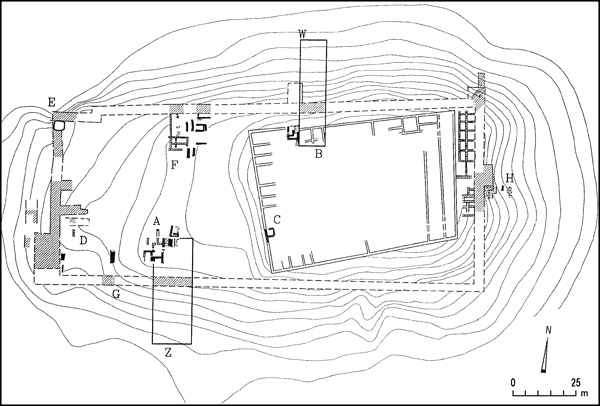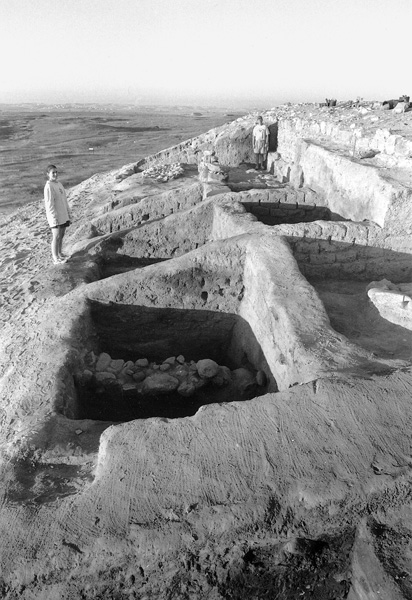Malḥata, Tel
EXCAVATIONS
Nine seasons of excavation have been conducted at Tel

EXCAVATION RESULTS
The stratigraphy revealed at the site is as follows:
- Stratum I: Late Roman period (two phases); second–third century CE.
- Stratum II: Hellenistic period; third–second centuries BCE.
- Stratum III: Iron Age IIC (two phases); mid-seventh century–beginning of sixth century BCE.
- Stratum IV: Iron Age IIB (two phases); end of eighth century BCE and mid-seventh century BCE.
- Stratum V: Iron Age IIB; end of tenth century BCE–ninth century BCE.
- Stratum VI: Middle Bronze Age IIB–C; eighteenth–sixteenth centuries BCE.
The results of the excavation of strata VI and III, the strata uncovered in the most recent excavations, are presented below.
THE FORTIFICATIONS. After the destruction of the stratum V city and an occupational gap of several generations, the new city that arose in the Iron Age IIB–C (strata III, IV) was surrounded by a 3.5-m-wide brick wall. The city wall was uncovered in areas A, D, E, F, and H. Brick towers projected from it in several places. In area F, it was exposed to a height of c. 3 m; beneath it was the 4.0-m-wide brick city wall attributed to stratum V, a portion of which was also exposed in area D. Earthen ramparts covered with pebbles (a glacis) were laid against the outer side of the earlier city wall, as may be seen in area H. A portion of a brick retaining wall, 5 m from the wall and 0.70 m from a tower, were also exposed in area H. Its function was to strengthen this segment of the fortifications and apparently support the top of the ramparts. A brick structure with two rooms and 3.5-m-thick walls, partially excavated in area D, abutted the city wall and seems to have functioned as an inner citadel, presumably next to the unexposed city gate.
THE BUILDINGS. Numerous bedouin tombs located at the top of the higher part of the mound limited the excavation area, which therefore focused upon the lower part of the mound and the top of the eastern slope of the higher part of the mound. In area A, later phases were uncovered of a pillared building first encountered during the early excavation seasons. It appears that the building was in existence from the tenth and ninth centuries BCE (stratum V) to the period of the last city of stratum III. To its immediate south were exposed two large buildings attributed to stratum III. One (12 by 10 m) is divided into six rooms and appears to have served as a public building; the other was only partially exposed. Two phases were discerned in both buildings: an early phase of brick construction and a later largely of stone. Both phases yielded homogeneous pottery assemblages.

Excavations in area F over an approximately 250-sq-m area uncovered building complexes, courtyards, and a street. Some of the structures abut the city wall. Two strata, IV and III, were noted in the excavation area, although there were structures in existence over the course of both strata that did not undergo architectural changes. Elsewhere, changes were manifested in the combination of stone and brick construction in stratum III. The excavation in this area did not descend to bedrock, and presently there is no evidence of earlier strata.
Some 500 sq m were excavated in area H. Along a 55-m stretch between the 3.5-m-thick wall and the eastern wall of the Roman citadel, a row of 14 pairs of small brick-built rooms with a pillared building (5 by 7 m) in the middle were found, as was a street running perpendicular to the city wall. The dimensions of the rooms, most of which were excavated, are c. 3 by 2.5 m. The eastern row of rooms abuts the city wall. Walls were preserved to a height of c. 3 m. In places where excavations were deepened (rooms 1507, 1548, 1587/8), two to three phases separated by up to 1 m were distinguished; excavations did not descend to bedrock in these spots, perhaps explaining why stratum IV was not encountered. The considerable amount of pottery collected is attributed to identical types dated from the second half of the seventh century to the beginning of the sixth century BCE. The finds from the rooms indicate that at least some of the rooms were used for crafts, such as room 1585, in which 250 loom weights were found. Several small altars, remains of wooden furniture, and a large number of bone inlays were found in the pillared building, suggesting that it had some official function. Signs of a conflagration that entirely destroyed the stratum III city were encountered, such as a particularly impressive 1.5-m-thick brick collapse layer unearthed in room 1507.
THE FINDS. Seven seasons of excavation produced a wide variety of artifacts.
Pottery. A small portion of the pottery is typical of the end of the eighth to the beginning of the seventh century BCE (stratum IV), while a large portion characterizes the seventh to the beginning of the sixth century BCE (stratum III). All types common at Negev sites are represented. Some 50 percent of the bowls found at the site are of the so-called “imitation Assyrian Palace ware.” A high percentage of the cooking pots belong to a group of vessels with broad mouth, no neck, and stepped rim, occasionally referred to as Edomite cooking pots because of the Nubian sandstone content in their fabric and their affinity to Edomite vessels. A number of vessels are of explicit Edomite origin, and include a decorated krater with triangular lugs; a krater with anklebone-shaped legs, the only known parallel to which was found at Bozrah in Edom; and a jar decorated with red geometric lines.
Inscriptions. Twelve inscriptions were found in various areas, most from area H. These include ostraca (generally fragmentary) and incisions. Paleographic examination of the inscriptions revealed some of them to be in Edomite script.

Small Finds. Over 20 clay figurines were found. Worthy of note is a figurine depicting a man playing a double flute; there are traces of paint on the face. From a figurative and technical point of view, there is considerable similarity between this and a macehead found at
ITZHAQ BEIT-ARIEH
EXCAVATIONS
Nine seasons of excavation have been conducted at Tel
